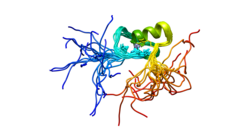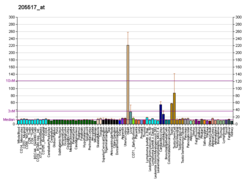| GATA4 |
|---|
 |
| Visualisation de la protéine Cristallisée GATA4 |
| Structures disponibles |
|---|
| PDB | Recherche d'orthologue: PDBe RCSB |
|---|
|
|
| Identifiants |
|---|
| Aliases | GATA4 |
|---|
| IDs externes | OMIM: 600576 MGI: 95664 HomoloGene: 1551 GeneCards: GATA4 |
|---|
| Position du gène (Homme) |
|---|
 | | Chr. | Chromosome 8 humain[1] |
|---|
| | Locus | 8p23.1 | Début | 11,676,959 bp[1] |
|---|
| Fin | 11,760,002 bp[1] |
|---|
|
| Position du gène (Souris) |
|---|
 | | Chr. | Chromosome 14 (souris)[2] |
|---|
| | Locus | 14 D1|14 33.24 cM | Début | 63,436,371 bp[2] |
|---|
| Fin | 63,509,141 bp[2] |
|---|
|
| Expression génétique |
|---|
| Bgee | | Humain | Souris (orthologue) |
|---|
| Fortement exprimé dans | - auricule droit
- ventricule gauche
- duodénum
- apex of heart
- left ovary
- artère coronaire droite
- right ovary
- body of pancreas
- artère coronaire gauche
- right testis
|
| | Fortement exprimé dans | - epithelium of stomach
- germinal epithelium
- antre du pylore
- duodénum
- granulosa cell of ovary
- mucous cell of stomach
- crête génitale
- cellule de Leydig
- theca folliculi
- Vésicule vitelline
|
| | Plus de données d'expression de référence |
|
|---|
| BioGPS |  | | Plus de données d'expression de référence |
|
|---|
|
| Gene Ontology |
|---|
| Fonction moléculaire | - liaison ADN
- sequence-specific DNA binding
- co-SMAD binding
- DNA-binding transcription factor activity
- transcription coactivator activity
- zinc ion binding
- transcription factor binding
- liaison de chromatine
- liaison ion métal
- liaison protéique
- cis-regulatory region sequence-specific DNA binding
- DNA-binding transcription factor activity, RNA polymerase II-specific
- RNA polymerase II transcription regulatory region sequence-specific DNA binding
- DNA-binding transcription activator activity, RNA polymerase II-specific
- protein kinase binding
- NFAT protein binding
- RNA polymerase II cis-regulatory region sequence-specific DNA binding
| | Composant cellulaire | - nucléoplasme
- RNA polymerase II transcription regulator complex
- noyau
- corps nucléaire
| | Processus biologique | - endoderm development
- male gonad development
- regulation of transcription, DNA-templated
- ventricular septum development
- cell growth involved in cardiac muscle cell development
- embryonic foregut morphogenesis
- endocardial cushion development
- cardiac muscle cell differentiation
- cell-cell signaling
- response to mechanical stimulus
- coagulation sanguine
- transcription by RNA polymerase II
- transcription, DNA-templated
- positive regulation of angiogenesis
- régulation positive de la transcription dépendante de l'ADN
- heart looping
- atrial septum morphogenesis
- response to vitamin A
- regulation of cardiac muscle cell contraction
- atrial septum secundum morphogenesis
- atrial septum primum morphogenesis
- intestinal epithelial cell differentiation
- embryonic heart tube anterior/posterior pattern specification
- positive regulation of BMP signaling pathway
- positive regulation of cardioblast differentiation
- positive regulation of vascular endothelial growth factor production
- negative regulation of autophagy
- cardiac ventricle morphogenesis
- cardiac right ventricle morphogenesis
- cellular response to glucose stimulus
- positive regulation of transcription by RNA polymerase II
- transdifférenciation
- aortic valve morphogenesis
- développement du cœur
- morphogenèse d'un organe animal
- histogenèse
- développement d'une cellule
- structure anatomique impliquée dans la morphogenèse
- digestive tract development
- cardiac muscle tissue development
- atrioventricular valve formation
- negative regulation of cardiac muscle cell apoptotic process
- regulation of protein kinase B signaling
- cardiac muscle tissue regeneration
- positive regulation of ERK1 and ERK2 cascade
- negative regulation of oxidative stress-induced cell death
- negative regulation of apoptotic signaling pathway
| | Sources:Amigo / QuickGO |
|
| Orthologues |
|---|
| Espèces | Homme | Souris |
|---|
| Entrez | | |
|---|
| Ensembl | |
|---|
ENSG00000136574
ENSG00000285109 |
| |
|---|
| UniProt | | |
|---|
| RefSeq (mRNA) | |
|---|
NM_001308093
NM_001308094
NM_002052
NM_001374273
NM_001374274 |
| |
|---|
| RefSeq (protéine) | |
|---|
NP_001295022
NP_001295023
NP_002043
NP_001361202
NP_001361203 |
| |
|---|
| Localisation (UCSC) | Chr 8: 11.68 – 11.76 Mb | Chr 14: 63.44 – 63.51 Mb |
|---|
| Publication PubMed | [3] | [4] |
|---|
|
| Wikidata |
| Voir/Editer Humain | Voir/Editer Souris |
|


 Portail de la biologie cellulaire et moléculaire
Portail de la biologie cellulaire et moléculaire 















